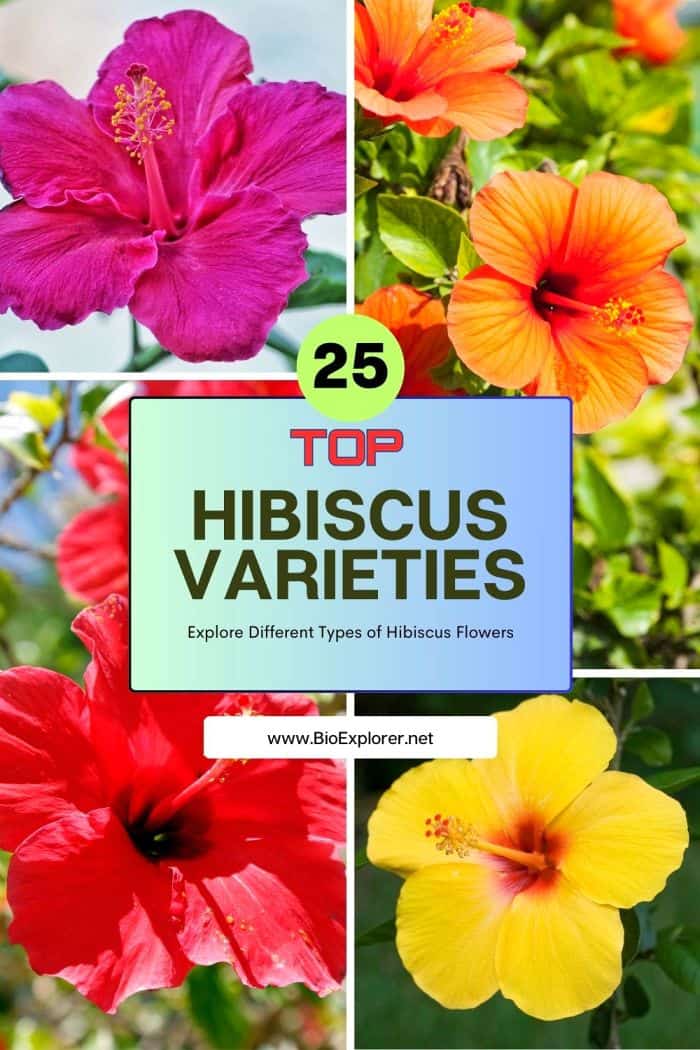
Hibiscus varieties and types of Hibiscus flowers are nature’s own fireworks, bursting with color and personality. These stunning blooms aren’t just pretty faces in the garden; they’ve captured hearts from backyard oases to tropical paradises worldwide.
Nature’s gone wild with Hibiscus, cooking up around 438 accepted species[1] across the globe. But that’s just the beginning of the Hibiscus story. Gardeners and botanists have been busy bees, creating thousands of hybrids and cultivars, expanding the range of Hibiscus varieties and types of Hibiscus flowers available to enthusiasts.
These man-made Hibiscus varieties come in every color of the rainbow and then some, with flowers ranging from demure daisies to dinner-plate-sized showstoppers. The hibiscus family tree keeps growing, with new varieties popping up faster than you can say “tropical paradise”.
Table of Contents
- Brief History of Hibiscus Flowers
- Top Hibiscus Flowers
- 1. Chinese Hibiscus (Hibiscus rosa-sinensis)
- 2. Rose of Sharon (Hibiscus syriacus)
- 3. Scarlet Rosemallow (Hibiscus coccineus)
- 4. Swamp Rose-mallow (Hibiscus moscheutos)
- 5. Confederate Rose (Hibiscus mutabilis)
- 6. Sea Hibiscus (Hibiscus tiliaceus)
- 7. Rose-of-Sharon (Hibiscus paramutabilis)
- 8. Hawaiian White Hibiscus (Hibiscus arnottianus)
- 9. Roselle (Hibiscus sabdariffa)
- 10. False Roselle (Hibiscus acetosella)
- 11. Fringed Hibiscus (Hibiscus schizopetalus)
- 12. Hawaiian Red Hibiscus (Hibiscus kokio)
- 13. Cotton Rosemallow (Hibiscus grandiflorus)
- 14. Dwarf Red Hibiscus (Hibiscus boryanus)
- 15. Lindenleaf Rosemallow (Hibiscus furcellatus)
- 16. Ma’o Hau Hele (Hibiscus brackenridgei)
- 17. Dixie Rosemallow (Hibiscus aculeatus)
- 18. Alyogyne (Hibiscus huegelii)
- 19. Mahoe (Hibiscus elatus)
- 20. Mallow Cup (Hibiscus trionum)
- 21. Kenaf (Hibiscus cannabinus)
- 22. Rosemallow (Hibiscus palustris)
- 23. Swamp Hibiscus (Hibiscus diversifolius)
- 24. Mandrinette (Hibiscus fragilis)
- 25. Rose-of-Venezuela (Hibiscus rosa-sinensis)
- Hibiscus Care 101: Keeping Your Blooms Happy
- Frequently Asked Questions
- How often should I water my Hibiscus?
- Can Hibiscus be grown indoors?
- Why are the leaves on my Hibiscus turning yellow?
- Do all hibiscus flowers only last one day?
- How do I overwinter my hibiscus?
- Are hibiscus plants toxic to pets?
- How can I encourage more blooms on my Hibiscus?
- Can I make tea from any hibiscus flower?
- Wrapping Up: Your Hibiscus Journey Begins Here
Brief History of Hibiscus Flowers
| Ancient Times | Hibiscus originates in Asia and Pacific islands, possibly in India. |
| 1678 | One of the earliest European descriptions of a double red hibiscus variety. |
| 1753 | Carl Linnaeus names and describesHibiscus rosa-sinensis. |
| 19th Century | Hibiscus becomes popular in Europe as “Stove Plants”[2]. |
| 1914 | The first hibiscus show held in Hawaii, featuring 400 selections[3]. |
| 1923 | The territory of Hawaii adopts Hibiscus as its official flower. |
| 1950s | Hibiscus cultivation has gained popularity in the continental United States. |
| Modern Day | Hibiscus is widely cultivated worldwide, with significant contributions from Australia and the United States. |

In Victorian flower language, the Hibiscus represented delicate beauty. It was sometimes given to signal that the giver thought the recipient was beautiful.
Top Hibiscus Flowers
The Hibiscus has traveled far and wide, adapting to new environments and weaving itself into the fabric of various cultures. As we dive into our list, remember that each of these flowers carries a rich history of global exploration, cultural exchange, and horticultural passion. Ready to continue our journey through the world of Hibiscus?
1. Chinese Hibiscus (Hibiscus rosa-sinensis)
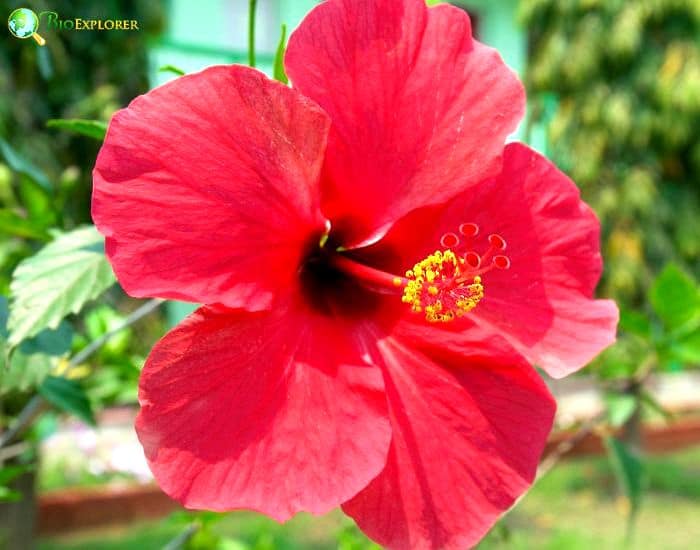
| Plantae | Malvales | Malvaceae | Hibiscus | Hibiscus rosa-sinensis |
The Chinese Hibiscus, also known as the Rose of China or Shoeblackplant, is a true showstopper in Hibiscus. This tropical beauty is renowned for its large, showy flowers and glossy green leaves. Native to tropical and subtropical regions of East Asia, it has become a beloved ornamental plant, prized for its vibrant blooms that can appear year-round in suitable climates.

- Flower Size: 3 to 6 inches in diameter[4].
- Colors: Red, pink, orange, yellow, white, and multi-colored varieties.
- Blooming Season: Year-round in tropical climates.
- Height: 3-15 feet tall, depending on variety and growing conditions.

While its exact origins are debated, it is likely from Southeast Asia, though some authorities point to Vanuatu in Oceania or various other tropical regions.

- In Hawaii, women wear the flower behind their ear to indicate relationship status: left ear if taken, right ear if single.
- In some cultures, the flowers are edible and often used in teas and salads.
- It’s the national flower of Malaysia.
- Despite its name, the Chinese Hibiscus is not used to make the common hibiscus tea. That’s usually made from Hibiscus sabdariffa, also known as Roselle.
2. Rose of Sharon (Hibiscus syriacus)
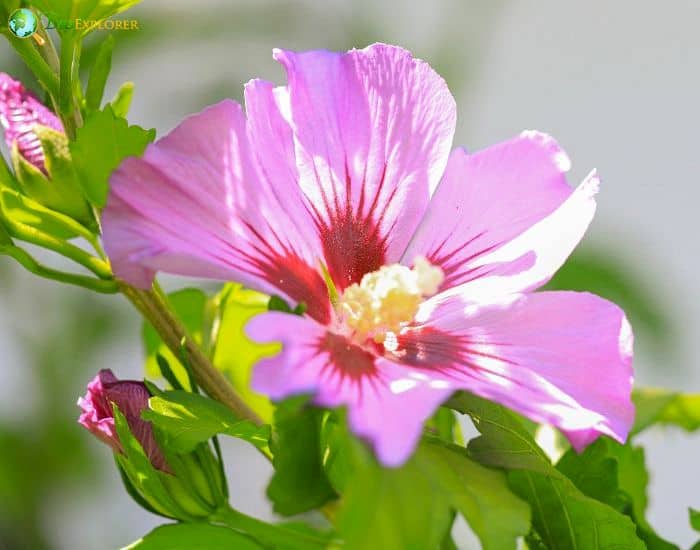
| Plantae | Malvales | Malvaceae | Hibiscus | Hibiscus syriacus |
The Rose of Sharon, also known as Althea or Syrian Ketmia, is a hardy hibiscus that brings a tropical flair to temperate gardens. This versatile shrub is beloved for its prolific summer blooms and easy-going nature. Despite its name suggesting Middle Eastern origins, it’s native to eastern Asia, particularly China.
The Rose of Sharon has gained popularity in many parts of the world for its ability to thrive in various climates and soil conditions. It offers gardeners in cooler regions hibiscus beauty without needing tropical temperatures.

- Flower Size: 2-4 inches in diameter.
- Colors: White, pink, red, purple, blue, and bicolor varieties.
- Blooming Season: Mid-summer to early fall.
- Height: 8-12 feet tall, 4-10 feet wide[5].

Despite its name, it’s native to eastern Asia, particularly China and India.

- It’s the national flower of South Korea, known as “Mugunghwa”.
- The flowers only last for a day, but the plant produces them in abundance.
- In the language of flowers, it represents “consumed by love”.
- Despite its common name, Rose of Sharon isn’t related to roses at all.
- It’s a member of the Mallow family, along with other hibiscus species.
3. Scarlet Rosemallow (Hibiscus coccineus)
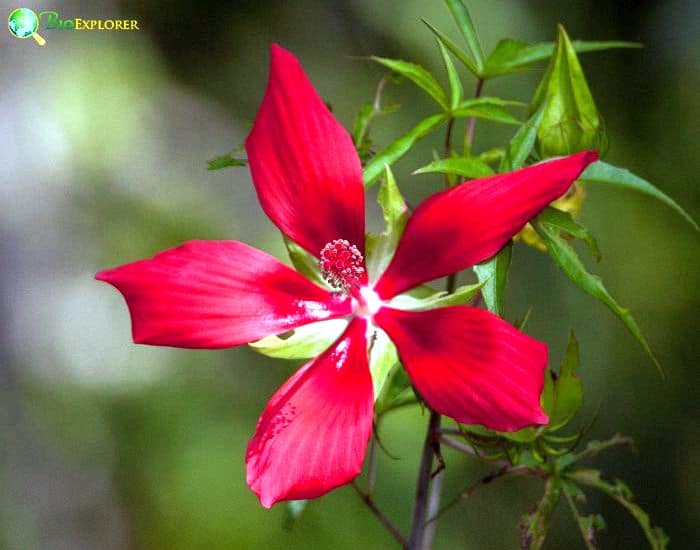
| Plantae | Malvales | Malvaceae | Hibiscus | Hibiscus coccineus |
The Scarlet Rosemallow, also known as the Texas Star Hibiscus, is a stunning native perennial that adds a bold splash of color to wetland gardens and natural landscapes. Endemic to the southeastern United States[6], this eye-catching plant is characterized by its brilliant scarlet flowers and deeply lobed, star-shaped leaves.
The Scarlet Rosemallow has gained popularity among gardeners and conservationists for its striking appearance, ability to attract pollinators, and importance in wetland ecosystems. Despite its tropical appearance, this hibiscus species is surprisingly hardy, capable of withstanding colder temperatures than many of its relatives.

- Flower Size: 3 to 6 inches in diameter.
- Colors: Vibrant scarlet red.
- Blooming Season: Mid-summer to early fall.
- Height: 4-8 feet tall, 2-4 feet wide.

Southeastern United States, particularly in wetland areas and along stream banks.

- The leaves are palmate and can be mistaken for marijuana, earning it the nickname “Swamp Mallow. “.
- Native Americans used the fibers from the stem to make cordage.
- It’s a favorite of Hummingbirds and butterflies.
- Despite its tropical appearance, it’s hardy in USDA zones 6-9.
- The plant is deer-resistant, making it a great choice for gardens in rural areas.
4. Swamp Rose-mallow (Hibiscus moscheutos)
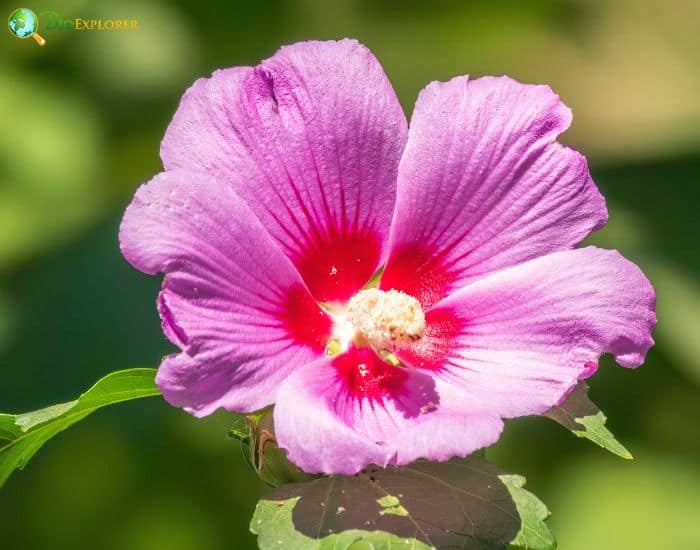
| Plantae | Malvales | Malvaceae | Hibiscus | Hibiscus moscheutos |
The Swamp Rose-mallow, also known as the Crimson-eyed Rosemallow or Eastern Rosemallow, is a hardy perennial hibiscus native to wetland areas of North America. This impressive plant is celebrated for its enormous, dinner-plate-sized flowers that bring a tropical flair to temperate gardens.
Despite its delicate appearance, the Swamp Rose-mallow is a robust species that thrives in wet conditions and can withstand cold winters. It is popular for water gardens, rain gardens, and naturalized areas. Its ability to blend showy, exotic-looking blooms with adaptability to various climates has made it a favorite among gardeners and a valuable plant for wildlife habitats.

- Flower Size: 6-8 inches in diameter.
- Colors: White, pink, or red, often with a crimson eye.
- Blooming Season: Mid-summer to early fall.
- Height: 3-7 feet tall, 2-4 feet wide.

Wetlands, marshes, and stream banks across eastern and southeastern United States.

- Also known as “Dinner Plate Hibiscus” due to its large flower size.
- The flowers only last for a day, but new blooms appear daily over several weeks.
- Native Americans used the plant’s fibers to make thread and rope.
- It’s the parent of many hardy hibiscus hybrids popular in gardens today.
- The plant is attractive to bees, butterflies, and hummingbirds.
- Swamp Rose-mallow flowering plant is listed as ‘Species of Special Concern’ under the ‘Species under Risk Act’ in Canada[7].
5. Confederate Rose (Hibiscus mutabilis)
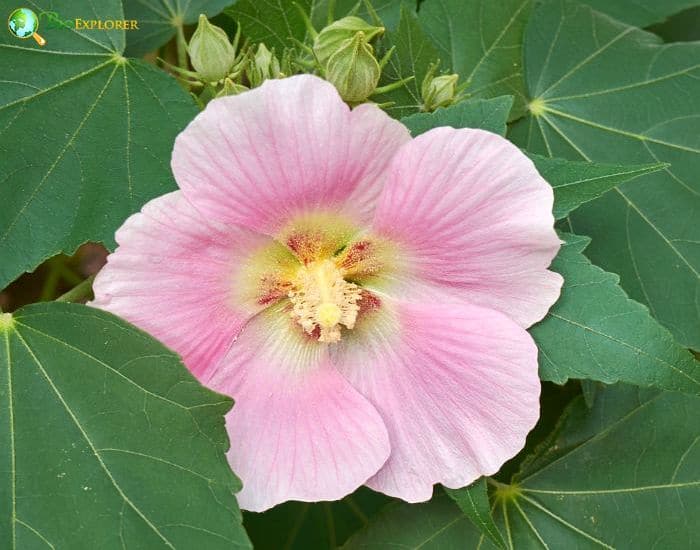
| Plantae | Malvales | Malvaceae | Hibiscus | Hibiscus mutabilis |
The Confederate Rose, also known as the Cotton Rosemallow or Changeable Rose, is a fascinating hibiscus species known for its color-changing flowers. Native to southern China, this captivating plant has become a beloved feature in many southern United States gardens, where it earned its common name.
The Confederate Rose is not a rose but a hibiscus that offers a unique display as its flowers transform from white or pale pink in the morning to deep pink or red by evening. With its large, showy blooms and robust growth habit, this chameleon-like quality makes it a conversation piece in any garden.

- Flower Size: 4-6 inches in diameter.
- Colors: Flowers open white or pink, changing to deep pink or red by evening[8].
- Blooming Season: Late summer to fall.
- Height: 6-15 feet tall, 6-10 feet wide.

Native to southern China but widely cultivated in warm regions worldwide.

- Despite its name, it’s not a true rose but a member of the hibiscus family.
- The flowers can change color multiple times in a single day.
- In cooler climates, it can be grown as an annual or in containers.
- Some varieties produce double or semi-double flowers.
- The plant has been cultivated in the southern United States since the 1800s.
- It’s sometimes called the “Cotton Rose” because its flower buds resemble cotton bolls.
6. Sea Hibiscus (Hibiscus tiliaceus)
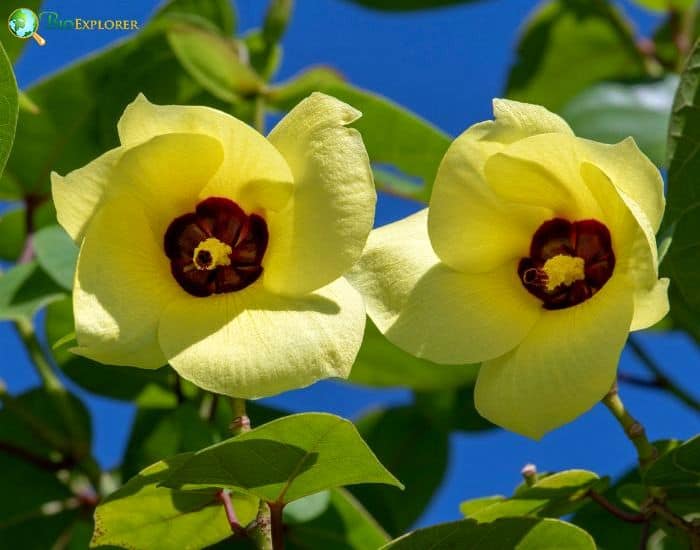
| Plantae | Malvales | Malvaceae | Hibiscus | Hibiscus tiliaceus |
The Sea Hibiscus, also known as Beach Hibiscus or Coastal Cottonwood, is a tropical tree or shrub known for its hardiness and adaptability to coastal conditions. Native to the shores of the Pacific and Indian Oceans, this versatile plant has spread to tropical and subtropical coastlines worldwide.
The Sea Hibiscus is prized for its ability to thrive in challenging seaside environments, tolerating salt spray, poor soils, and strong winds. Its large, heart-shaped leaves provide ample shade, while its Yellow Flowers, which change to orange and red as they age, offer a daily spectacle of color.

- Flower Size: 3-4 inches in diameter.
- Colors: Yellow with a dark red center, changing to orange-red as the day progresses.
- Blooming Season: Year-round in tropical climates.
- Height: 12 to 25 feet tall, with a similar spread.

Coastal areas of the Pacific and Indian Oceans, including tropical Asia, Oceania, and parts of East Africa.

- Its wood is resistant to termites and is used in construction in many Pacific islands.
- The bark fibers are traditionally used to make ropes, mats, and grass skirts.
- It’s salt-tolerant, making it an excellent choice for seaside gardens.
- The leaves are heart-shaped and can be up to 8 inches wide.
- In Hawaii, it’s known as “Hau” and is used in traditional lei-making.
- The flowers open in the morning and usually fall by nightfall, replaced by new blooms the next day.
7. Rose-of-Sharon (Hibiscus paramutabilis)
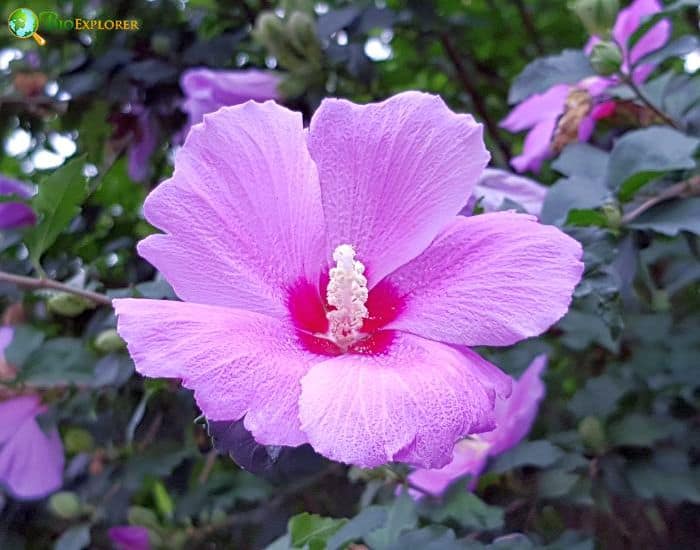
The Rose-of-Sharon (Hibiscus paramutabilis), not to be confused with Hibiscus syriacus, which shares the same common name[9], is a lesser-known but equally beautiful hibiscus species native to central and southern China.
This deciduous shrub or small tree captivates gardeners with its large, showy flowers that typically bloom in shades of pink or white. The species name “paramutabilis” means “nearly changeable”, hinting at the subtle color variations its flowers may display as they age.

- Flower Size: 3-5 inches in diameter.
- Colors: Typically, pink or white, sometimes with a darker center.
- Blooming Season: Mid-summer to early fall.
- Height: 6-10 feet tall, 4-6 feet wide.

Native to central and southern China.

- The species name “paramutabilis” means “nearly changeable, ” referring to its flowers that may change color slightly as they age.
- It’s less common in cultivation than its relative, Hibiscus syriacus.
- The flowers are often described as having a silky texture.
- In its native habitat, it’s found in forests and thickets[10].
- Like many hibiscus species, its flowers are attractive to pollinators.
- It’s sometimes called the “Chinese Hibiscus, ” though this name is more commonly used for Hibiscus rosa-sinensis.
8. Hawaiian White Hibiscus (Hibiscus arnottianus)
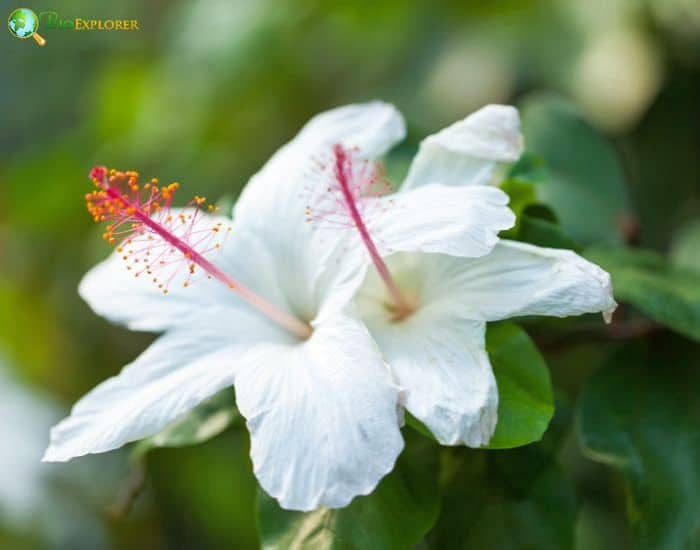
| Plantae | Malvales | Malvaceae | Hibiscus | Hibiscus arnottianus |
The Hawaiian White Hibiscus, also known as Kokio Keokeo, is a rare and beautiful species native to the Hawaiian Islands[11]. The Hawaiian White Hibiscus is a true gem in the world of Hibiscus. Its pristine White Flowers and enchanting fragrance make it a prized addition to tropical gardens.
While it’s best suited to warm, humid climates, it can be grown in containers and brought indoors in cooler regions. As an endemic Hawaiian plant, it represents the islands’ unique biodiversity. It serves as a reminder of the importance of conservation efforts for rare and threatened species.

- Flower Size: 4-6 inches in diameter.
- Colors: Pure white with a striking red staminal column.
- Blooming Season: Year-round in tropical climates, heaviest in spring and summer.
- Height: 10-30 feet tall, 20-25 feet wide.

- It’s one of the few naturally white-flowered hibiscus species.
- The flowers are known for their sweet, Jasmine-like fragrance. The Hawaiian White Hibiscus is one of the Fragrant Flowers in the genus Hibiscus.
- In Hawaiian culture, it’s considered a symbol of royalty and is used in lei-making.
- There are several subspecies, each native to different Hawaiian Islands.
- It’s listed as a threatened species due to Habitat Loss and competition from invasive plants[12].
- The red staminal column can extend up to 4 inches beyond the petals, adding to its unique appearance.
9. Roselle (Hibiscus sabdariffa)
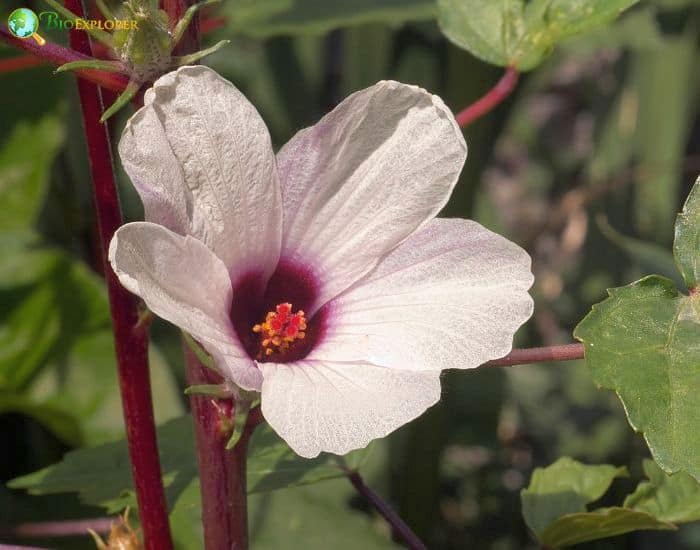
| Plantae | Malvales | Malvaceae | Hibiscus | Hibiscus sabdariffa |
Roselle, also known as Red Sorrel or Jamaica Sorrel, is a hibiscus that wears many hats. Its vibrant red calycesWhat is calyces?A collective term for all the sepals of a flower; the lowermost whorl of floral orgrans (Plural form is calyces). aren’t just eye-catching — they’re edible, too. Native to West Africa, this versatile plant now brightens gardens and kitchens worldwide.
Foodies prize Roselle’s tart, cranberry-like flavor, perfect for teas, jams, and trendy cocktails. Gardeners can’t resist its showy blooms and striking red stems.
Surprisingly, it’s not the petals but the fleshy calyces that give “hibiscus tea” its distinctive taste. Whether admiring its beauty or savoring its flavor, Roselle proves that some flowers are more than a pretty face.

- Flower Size: 3-4 inches in diameter.
- Colors: Pale yellow to pink with a dark red center.
- Blooming Season: Late summer to fall.
- Height: 3-8 feet tall, 3-5 feet wide.

Believed to be native to West Africa but now cultivated worldwide in tropical and subtropical regions.

- The fleshy calyx (not the flower) makes the popular “hibiscus tea. “.
- Rich in Vitamin C, it’s used in traditional medicine to treat various ailments.
- In the Caribbean, it’s a key ingredient in the festive drink “sorrel” (Christmas drink[13]).
- The leaves are edible and used in salads or cooked like spinach.
- It’s an annual in most regions but can be perennial in frost-free areas.
- In some cultures, it’s believed to have properties that lower blood pressure.
- The plant has traditional medicinal uses and is known for its health benefits, including antihypertensive and anti-inflammatory properties[14].
10. False Roselle (Hibiscus acetosella)
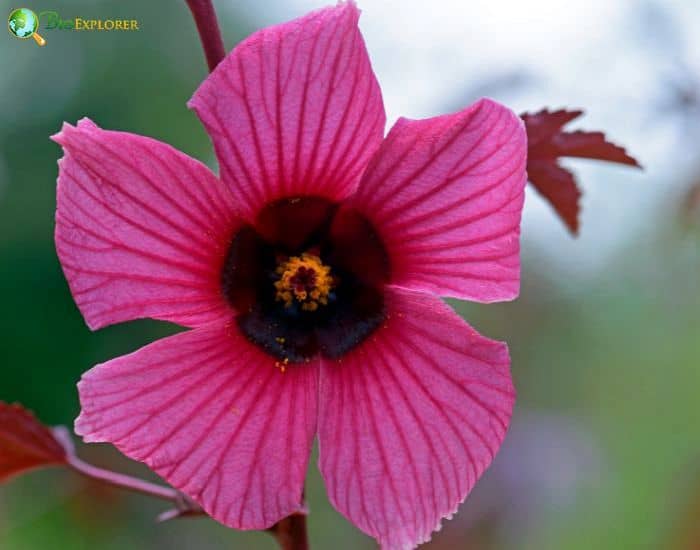
| Plantae | Malvales | Malvaceae | Hibiscus | Hibiscus acetosella |
False Roselle, African Rose Mallow, or Red-leaf Hibiscus — this plant goes by many names, but its striking appearance is unforgettable. With deep burgundy leaves that could rival any flower for beauty, Hibiscus acetosella is a showstopper in the garden.
It’s not just a pretty face, though — this versatile Hibiscus pulls double duty as an ornamental and an edible plant. Gardeners love it for its bold foliage, while culinary enthusiasts use its tart leaves to add zing to salads and teas.
Native to tropical and southern Africa, it’s now a global garden star. The leaves’ vibrant color comes from anthocyanins, the same compounds that give red wine its hue. Whether you’re planting it for looks or taste, False Roselle proves that sometimes, it’s the leaves that steal the show.

- Flower Size: 2-3 inches in diameter.
- Colors: Deep burgundy to almost black.
- Blooming Season: Late summer to fall.
- Height: 3-6 feet tall[15], 2-4 feet wide.
- Foliage: Deep red to purple, Maple-like leaves.

Native to tropical and southern Africa.

- Often grown more for its colorful foliage than its flowers.
- The leaves are edible and have a tart, lemony flavor.
- It can be used as a natural pH indicator due to pigments in its leaves.
- Often mistaken for Japanese maple due to its leaf shape[16].
- In some regions, it’s used as a hedgeplant.
- The flowers, while small, are attractive to pollinators.
11. Fringed Hibiscus (Hibiscus schizopetalus)
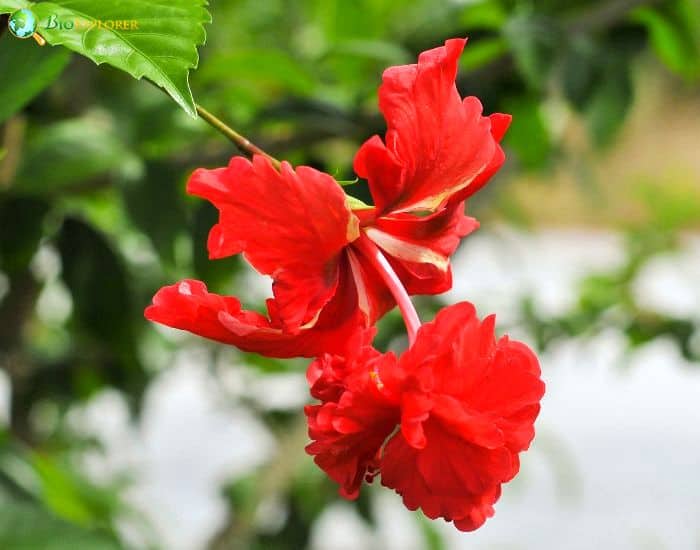
| Plantae | Malvales | Malvaceae | Hibiscus | Hibiscus schizopetalus |
Fringed Hibiscus, Japanese Lantern, or Coral Hibiscus — this flower’s names hint at its unique charm. Hibiscus schizopetalus stands out with its deeply fringed petals, creating a delicate, almost lacy appearance[17]. Additional names include Chinese Lantern, Skeleton Hibiscus, and Pagoda Flower.
Native to tropical East Africa, this showstopper now graces gardens worldwide with its pendulous, coral-colored blooms. Gardeners adore it for its exotic look, often showcasing it in hanging baskets where its drooping flowers can shine.
The plant’s scientific name, “schizopetalus“, literally means “split petal”, perfectly describing its distinctive feature.

- Flower Size: 2-3 inches in diameter.
- Colors: Usually red or pink, sometimes with white or yellow variations.
- Blooming Season: Year-round in tropical climates, heaviest in summer.
- Height: 6-12 feet tall, 3-6 feet wide.
- Flower Shape: Pendulous with deeply fringed, recurved petals.

Native to tropical East Africa, particularly Kenya and Tanzania.

- The species name “schizopetalus” means “split petal” in Latin.
- Its unique flower shape is believed to be an adaptation to attract sunbirds for pollination.
- Often used in hanging baskets due to its pendulous flowers.
- It can be trained as a small tree or espalier reaching 6-9 feet in height[18].
- Popular in tropical and subtropical regions for its year-round blooming potential.
12. Hawaiian Red Hibiscus (Hibiscus kokio)
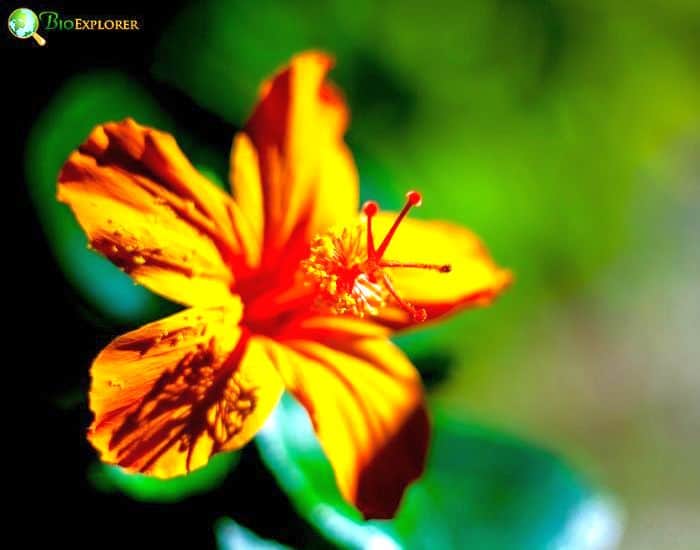
| Plantae | Malvales | Malvaceae | Hibiscus | Hibiscus kokio |
Hawaiian Red Hibiscus, or Kokio ula ula in Hawaiian[19], is a rare beauty native to the tropical paradise of Hawaii. This vibrant flower stands out with its deep red petals. This color seems to capture the fiery spirit of its volcanic homeland.
Endemic to the Hawaiian Islands, it’s not just a pretty face — it’s a vital part of the islands’ ecosystem and culture. Traditionally, Hawaiians used its sturdy wood for tools and its vibrant blooms in lei making.
Unlike many hibiscus species, Kokio ula ula’s flowers can last several days, providing a longer-lasting spectacle. Despite its stunning appearance, this species is threatened in the wild, symbolizing Hawaii’s fragile and unique biodiversity.
Whether you’re admiring its beauty or appreciating its cultural significance, the Hawaiian Red Hibiscus offers a glimpse into the natural treasures of the Aloha State.

- Flower Size: 2-3 inches in diameter.
- Colors: Typically, bright red, but can also be orange or yellow.
- Blooming Season: Year-round in its native habitat.
- Height: 6-15 feet tall, 3-6 feet wide.
- Leaves: Dark green, glossy, and elongated.

Endemic to the Hawaiian Islands, particularly found on Kauai, Oahu, Maui, and Hawaii (Big Island).

- It’s one of the few naturally red-flowered hibiscus species native to Hawaii[20].
- In Hawaiian culture, it’s considered sacred and was used in lei-making for royalty.
- The flowers are nectar-rich and attract native Hawaiian honeycreepers.
- It’s listed as a threatened species due to habitat loss and competition from invasive plants.
- There are several subspecies, each adapted to different ecological niches on the islands.
- Unlike many cultivated hibiscuses, its flowers tend to stay open for several days.
13. Cotton Rosemallow (Hibiscus grandiflorus)
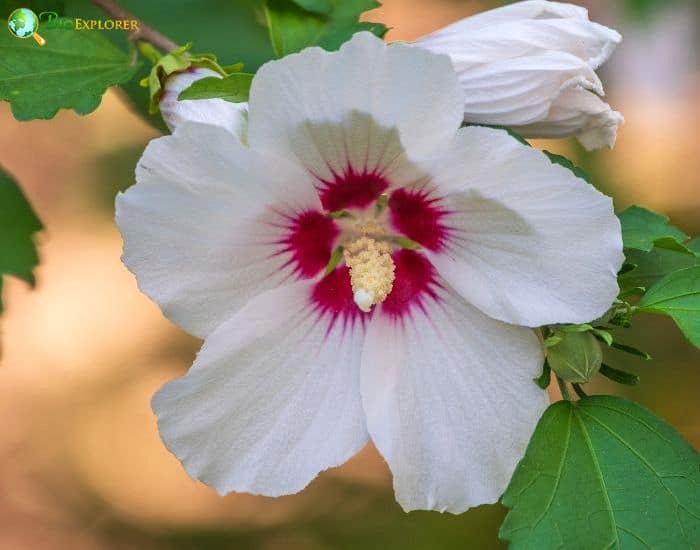
| Plantae | Malvales | Malvaceae | Hibiscus | Hibiscus grandiflorus |
The Cotton Rosemallow, also known as Swamp Rosemallow or Giant Rosemallow, is a stunning native perennial known for its exceptionally large flowers. The Cotton Rosemallow is a showstopper in any garden. It is particularly valued for its enormous flowers that can be as large as dinner plates.
Its tall stature and impressive blooms make it an excellent background plant or focal point in a mixed perennial border or rain garden. While it’s naturally adapted to wetland conditions, it can thrive in average garden soils as long as it receives consistent moisture.
This native beauty combines the exotic allure of tropical Hibiscus with the hardiness needed for temperate gardens, making it a versatile choice for gardeners looking to make a big impact.

- Flower Size: 6-12 inches in diameter, among the largest in the genus.
- Colors: Pale pink to white, often with a deep red or purple center.
- Blooming Season: Late summer to early fall.
- Height: 4-8 feet tall, 3-5 feet wide.
- Leaves: Large, velvety, and often lobed.

Southeastern United States, particularly in wetlands and coastal areas from North Carolina to Florida and west to Texas.

- Its scientific name, “grandiflorus” means “large-flowered” in Latin[21].
- Despite its common name, it’s not related to cotton plants.
- The flowers only last for a day, but the plant produces them in abundance.
- It’s a favorite nectar source for hummingbirds and butterflies.
- Native Americans used the fibers from the stem to make cordage.
- In the wild, it often grows alongside cypress trees in swamps.
14. Dwarf Red Hibiscus (Hibiscus boryanus)
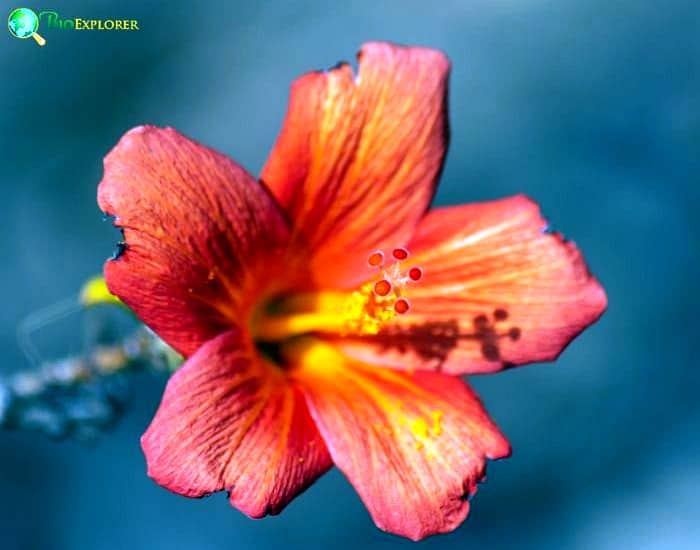
The Dwarf Red Hibiscus, also known as Bory’s Hibiscus, is a compact species native to the Mascarene Islands in the Indian Ocean. The Dwarf Red Hibiscus is a charming and compact species that brings a tropical flair to smaller gardens or containers.
Its vibrant red flowers contrast sharply against its dark green foliage, creating a beautiful display year-round in warm climates. While it’s not as widely available as some other hibiscus species, it’s prized by collectors and enthusiasts for its unique heritage and compact growth habit.
In cooler regions, it can be grown in containers and brought indoors during winter, allowing gardeners in various climates to enjoy this rare and beautiful Hibiscus.

- Flower Size: 2-3 inches in diameter.
- Colors: Bright red to deep crimson.
- Blooming Season: Year-round in tropical climates, heaviest in summer.
- Height: 3-6 feet tall, 2-4 feet wide.
- Leaves: Dark green, glossy, and ovate.

Endemic to Reunion Island and Mauritius in the Mascarene Islands.

- Named after French botanist Jean-Baptiste Bory de Saint-Vincent[22].
- It’s considered a rare species in its native habitat due to habitat loss.
- The flowers are attractive to sunbirds, important pollinators in its native ecosystem.
- Its compact size makes it suitable for container gardening.
- In cultivation, it’s sometimes used as a parent plant for developing new hibiscus hybrids.
- The species is part of conservation efforts on Reunion Island and Mauritius.
15. Lindenleaf Rosemallow (Hibiscus furcellatus)
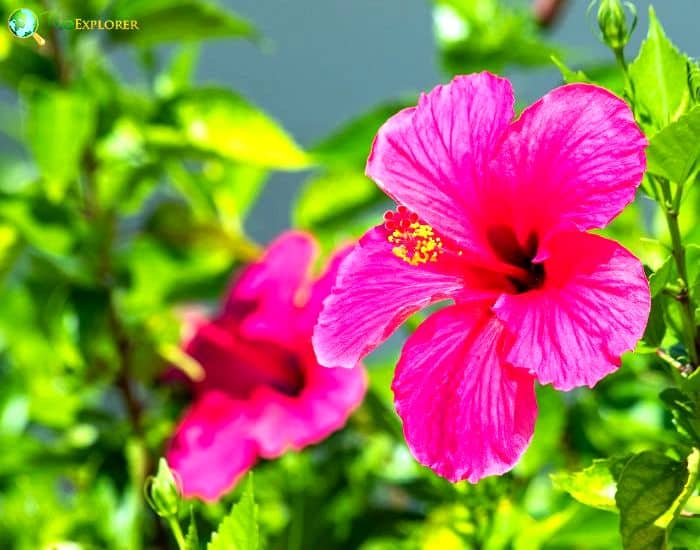
| Plantae | Malvales | Malvaceae | Hibiscus | Hibiscus furcellatus |
The Lindenleaf Rosemallow, also known as the Forked Rosemallow, is a lesser-known but beautiful hibiscus species native to tropical America[23]. The Lindenleaf Rosemallow is a charming addition to tropical and subtropical gardens, offering delicate pink flowers and attractive foliage.
Its natural affinity for moist areas makes it an excellent choice for water gardens, bog gardens, or any spot in the landscape that tends to stay damp. While it may not be as showy as some hibiscus relatives, its subtle beauty and adaptability to wet conditions make it a valuable plant for specific garden situations.

- Flower Size: 3-4 inches in diameter.
- Colors: Typically pink to lavender, sometimes with a darker center.
- Blooming Season: Year-around
- Height: 6-10 feet tall, 2-4 feet wide.
- Leaves: Heart-shaped, resembling linden tree leaves, hence the common name.

Native to tropical and subtropical regions of the Americas, from Florida and the Caribbean to parts of South America. It is specifically indigenous to Hawaii, found on Kauaʻi, Oʻahu, Maui, and Hawaiʻi islands.

- This flower has several Hawaiian names, including ʻAkiahala, ʻAkiohala, Aloalo, Hau hele, and Hau hele wai.
- It’s often found growing near water in its native habitats.
- The plant is long-lived, surviving for more than 5 years.
- While not as widely cultivated as some hibiscus species, it’s valued in native plant gardens.
- The plant can tolerate brief periods of flooding, making it suitable for rain gardens.
- An interesting pollination fact: carpenter bees visiting the flowers can become covered in purple pollen, making them appear purple when they fly out.
16. Ma’o Hau Hele (Hibiscus brackenridgei)
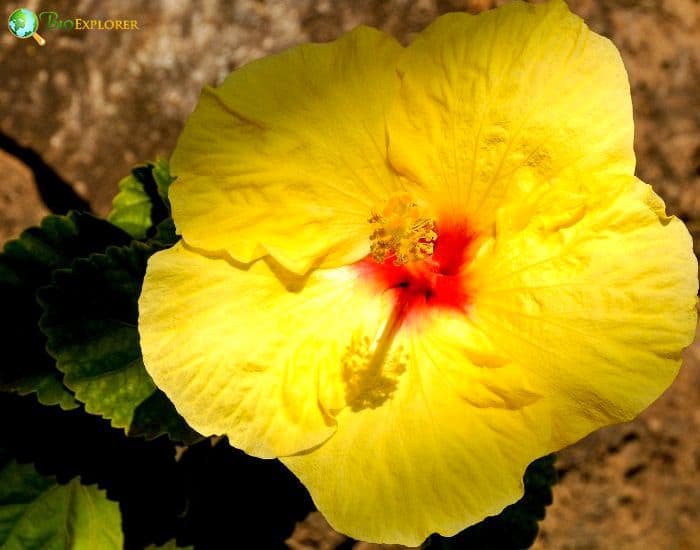
| Plantae | Malvales | Malvaceae | Hibiscus | Hibiscus brackenridgei |
Ma’o hau hele, also known as Hawaiian Yellow Hibiscus, is a rare and striking species with a special place in Hawaiian culture and Ecology. This endemic plant is not only beautiful but also carries the distinction of being the official state flower of Hawaii since 1988, replacing the red Hibiscus, which had been the unofficial state flower for decades.
There are three subspecies[24] of Hibiscus brackenridgei: brackenridgei (Endangered), molokaiana (Extinct in the wild), and mokuleianus (Endangered).

- Flower Size: 4-6 inches in diameter.
- Colors: Bright yellow with a maroon center.
- Blooming Season: Spring to early summer, but can bloom year-round in ideal conditions.
- Height: 10-15 feet tall, 8-12 feet wide.
- Leaves: Light green, deeply lobed, and coarsely toothed.

Endemic to dry forests and shrublands on all main Hawaiian Islands, but now extremely rare in the wild.

- It’s the official state flower of Hawaii, chosen for its yellow color, which represents royalty in Hawaiian culture.
- The species is federally listed as endangered due to habitat loss and invasive species.
- Its Hawaiian name, “Ma’o hau hele” means “green traveling hibiscus. “.
- The flowers only last one day but are produced in abundance during blooming season.
- In ancient Hawaii, the bark was used to make cordage[25].
- It’s one of the few yellow-flowered species of Hibiscus native to Hawaii.
17. Dixie Rosemallow (Hibiscus aculeatus)
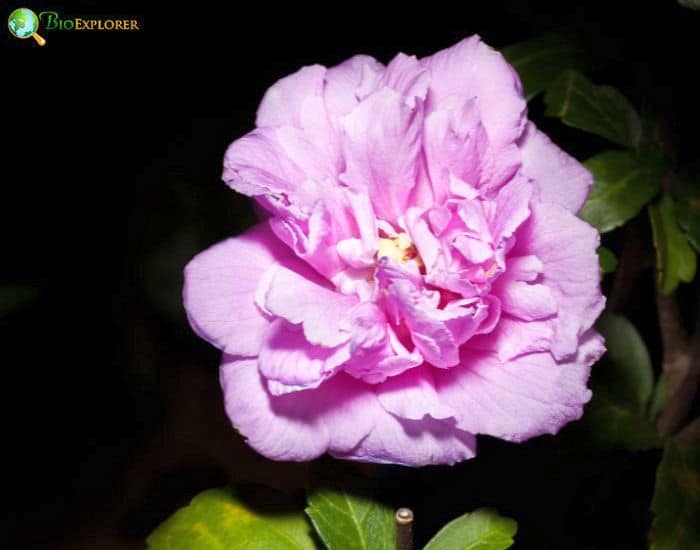
| Plantae | Malvales | Malvaceae | Hibiscus | Hibiscus aculeatus |
The Dixie Rosemallow, also known as the Prickly Rosemallow, is a charming and resilient native of the southeastern United States[26]. This perennial Hibiscus stands out for its unique combination of delicate flowers and prickly stems. It is an intriguing addition to native plant gardens and naturalized landscapes.

- Flower Size: 3-5 inches in diameter.
- Colors: Pale pink to white with a dark red center.
- Blooming Season: Late spring to early fall.
- Height: 3-6 feet tall, 2-3 feet wide.
- Leaves: Deeply lobed, reminiscent of okra leaves.

Southeastern United States, from South Carolina to Florida and west to Louisiana, typically in pine flatwoods and wet prairies.

- The species name “aculeatus” means “prickly, ” referring to the plant’s bristly stems.
- Its roots were used medicinally by Native Americans, hence the name “Comfort Root”.
- The flowers open in the morning and typically last only one day.
- It’s a larval host plant for the Gray Hairstreak butterfly[27].
- Despite its prickly nature, it’s deer-resistant, making it valuable in areas with high deer populations.
- In the wild, it often grows alongside wiregrass and longleaf pines in fire-dependent ecosystems.
18. Alyogyne (Hibiscus huegelii)
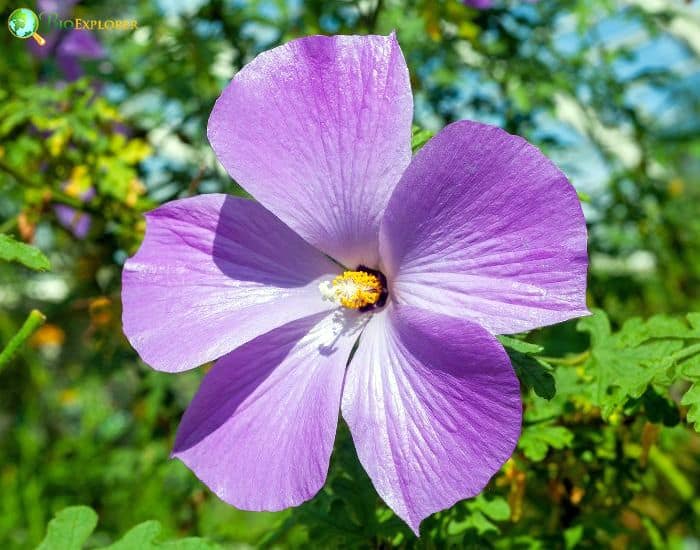
Alyogyne, formerly classified as Hibiscus huegelii and commonly known as the Blue Hibiscus or Lilac Hibiscus, is a stunning Australian native[28] that brings a unique color palette to the Hibiscus family. This versatile shrub has gained popularity recently for its drought tolerance and prolific blooming, making it a favorite in water-wise gardens.
Despite reclassifying the Alyogyne genus, it retains many characteristics that endear it to hibiscus lovers and continues to be closely associated with its hibiscus cousins.

- Flower Size: 3-4 inches in diameter.
- Colors: Lavender to purple, occasionally white or pink.
- Blooming Season: All year in suitable climates.
- Height: 6-10 feet tall, 4-8 feet wide.
- Leaves: Deeply lobed, grayish-green, giving a soft, velvety appearance.

Western and South Australia, typically in coastal and sub-coastal areas.

- Despite its common name, “Blue Hibiscus, ” its flowers are more accurately described as lavender or purple.
- It’s sometimes called “Swan River Hibiscus” after the Swan River in Western Australia.
- The flowers close at night and on overcast days.
- It’s a popular choice for hedges and screens in its native Australia.
- The plant is attractive to bees and butterflies.
- Unlike many hibiscus species, it’s quite tolerant of coastal conditions, including salt spray.
19. Mahoe (Hibiscus elatus)
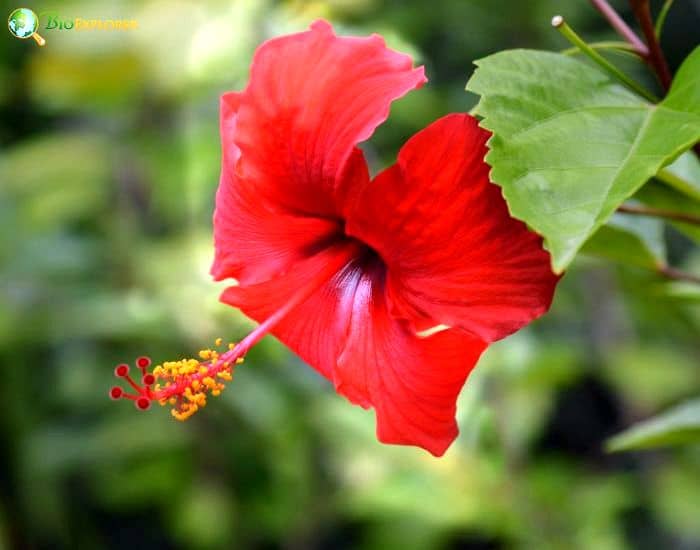
| Plantae | Malvales | Malvaceae | Hibiscus | Hibiscus elatus |
Mahoe, also known as Blue Mahoe or Mountain Mahoe, is a remarkable Tree Species that belongs to the hibiscus family. Native to the Caribbean[29], this impressive plant is not only valued for its ornamental qualities but also for its significant economic importance. It is also called “majó azul” in Spanish.
As the national tree of Jamaica, Mahoe holds a special place in Caribbean culture and ecology. Its unique combination of beautiful flowers, useful timber, and ecological adaptability makes it a fascinating subject for botanists and woodworkers.

- Flower Size: 3-4 inches in diameter.
- Colors: Flowers open yellow in the morning, changing to orange and finally deep red by evening[30].
- Blooming Season: Year-round in tropical climates, with peak flowering in summer.
- Height: Can grow up to 80 feet tall in ideal conditions.
- Leaves: Large, heart-shaped, dark green leaves.

Caribbean islands, particularly Jamaica, Cuba, and Puerto Rico, are typically found in moist forests at mid to high elevations.

- The wood of Mahoe is highly prized for its beautiful blue-green color and is used in fine furniture and musical instruments[31].
- It’s the national tree of Jamaica and appears on the country’s coat of arms.
- The flowers change color throughout the day, a characteristic known as ephemeral.
- The inner bark was traditionally used to make rope.
- In optimal conditions, Mahoe can grow quite rapidly, up to 6 feet per year.
- Despite being a tree, it’s closely related to shrubby hibiscus species and shares many floral characteristics.
20. Mallow Cup (Hibiscus trionum)
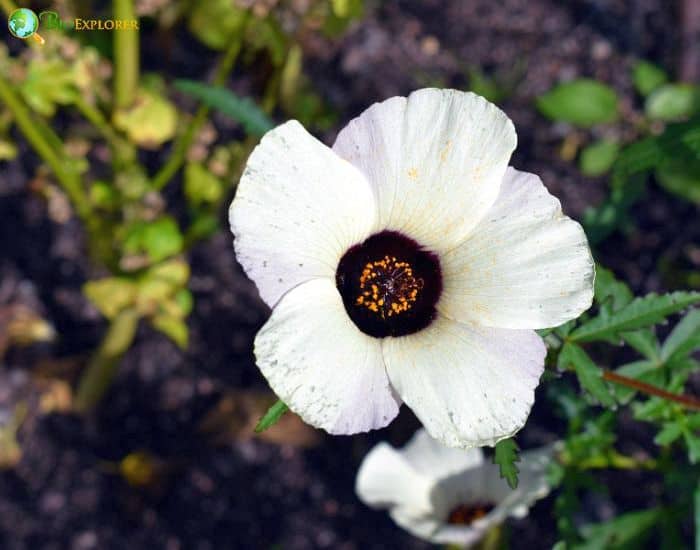
| Plantae | Malvales | Malvaceae | Hibiscus | Hibiscus trionum |
The Mallow Cup, also known as Flower-of-an-hour or Venice Mallow, is a fascinating annual hibiscus species[32] that has spread worldwide from its origins in Africa and temperate Asia. This delicate plant earns its common name from the fleeting nature of its blooms, which typically last only a few hours.
Despite its short-lived flowers, the Mallow Cup has captured the interest of gardeners and botanists alike for its unique characteristics and ability to thrive in various environments, sometimes to the point of becoming invasive in certain regions.

- Flower Size: 1-2 inches in diameter.
- Colors: Pale yellow or white petals with a dark purple center.
- Blooming Season: Summer to early fall.
- Height: 1-2 feet tall, with a similar spread.
- Leaves: Deeply lobed, giving a lacy appearance.

Originally from Africa and temperate parts of Asia, it is now naturalized in many parts of the world.

- The species name “trionum” comes from the Greek word for “three, ” referring to the three-lobed capsule that forms after the flower fades.
- Its flowers typically open in the morning and close by afternoon, hence the name “Flower-of-an-hour. “.
- The inflated calyx that surrounds the developing seed pod resembles a paper lantern.
- In some cultures, the leaves are used as a vegetable.
- It’s considered a weed in some agricultural settings due to its prolific self-seeding.
- The plant has naturalized on every continent except Antarctica, demonstrating its adaptability.
21. Kenaf (Hibiscus cannabinus)
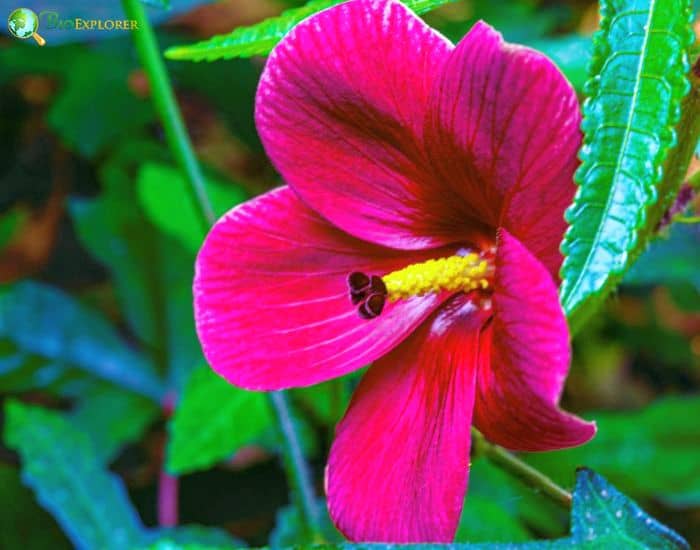
| Plantae | Malvales | Malvaceae | Hibiscus | Hibiscus cannabinus |
Kenaf, also known as Deccan hemp or Bimli jute, is a versatile and economically significant member of the hibiscus family. This fast-growing annual plant has been cultivated for thousands of years, primarily for its strong fibers.
In recent years, Kenaf has gained renewed interest as a sustainable alternative to wood pulp in paper production and as a potential biofuel crop[33].
Despite its industrial applications, Kenaf retains the ornamental charm characteristic of the hibiscus genus, making it an intriguing plant for those interested in both beauty and utility in their gardens.

- Flower Size: 3-4 inches in diameter.
- Colors: Cream or yellow with a dark maroon center.
- Blooming Season: Late summer to fall.
- Height: Can grow up to 12-18 feet tall in a single growing season.
- Leaves: Deeply lobed, resembling those of cannabis (hence the species name “cannabinus”).

Believed to be native to southern Asia but has been cultivated in Africa for millennia.

- Kenaf can produce 3-5 times more fiber per acre than pine trees[34].
- The fiber is used in making rope, twine, coarse cloth, and paper[35].
- Its leaves and seeds are edible and used in some cuisines.
- The plant is often used in phytoremediation to remove toxins from soil.
- In some countries, it’s being explored as a potential biofuel crop.
- Despite its industrial uses, Kenaf still produces attractive hibiscus-like flowers.
22. Rosemallow (Hibiscus palustris)
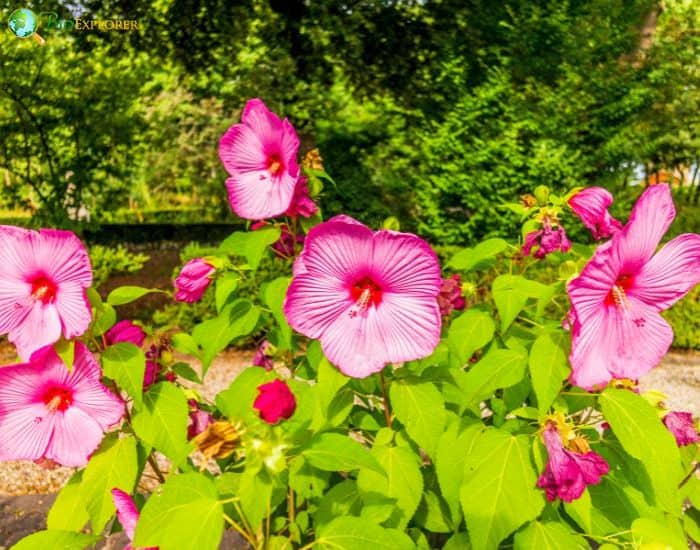
| Plantae | Malvales | Malvaceae | Hibiscus | Hibiscus palustris |
Rosemallow, also known as Swamp Rose-mallow or Eastern Rosemallow, is a striking perennial hibiscus native to wetland areas of eastern North America. This Marshmallow Hibiscus plant brings the tropical allure of large, showy flowers to temperate climates, making it a favorite among gardeners looking to add drama to wet areas of their landscapes.
Its ability to thrive in marshy conditions and impressive blooms have made it an important species for ornamental horticulture and wetland restoration projects.

- Flower Size: 4-7 inches in diameter.
- Colors: Usually pink or white, often with a red center or veining.
- Blooming Season: Mid to late summer.
- Height: 4-8 feet tall, with a spread of 2-4 feet.
- Leaves: Broad, ovate to lanceolate, sometimes with shallow lobes.

Eastern North America[36], from Ontario and Quebec south to Florida and west to Texas, is typically found in marshes, swamps, and riverbanks. Also found in California, Utah, and New Mexico.

- Often confused with Hibiscus moscheutos, it was once considered a variety of that species.
- The flowers are hermaphroditic[37], containing both male and female parts.
- Native Americans used the plant’s fibers to make cord and thread.
- Its large flowers are attractive to hummingbirds and various pollinators.
- The plant is deer-resistant, making it valuable in areas with high deer populations.
- In some regions, it’s used in wetland restoration projects due to its ability to stabilize shorelines.
23. Swamp Hibiscus (Hibiscus diversifolius)
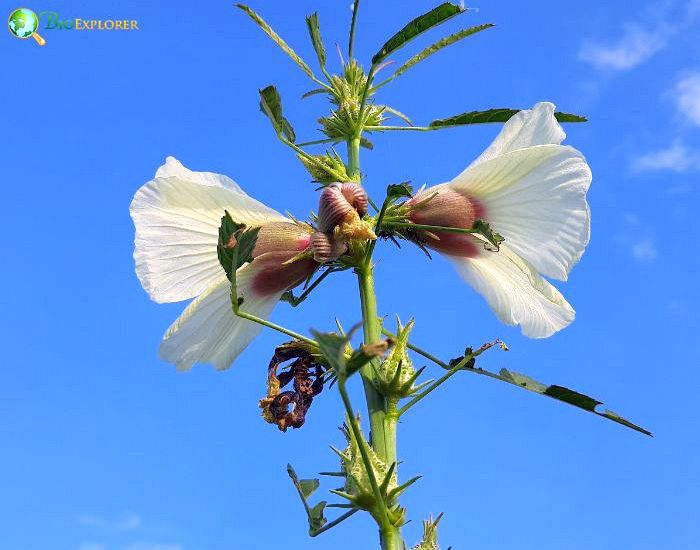
Swamp Hibiscus, also known as Swamp Rose-mallow or Prickly Hibiscus, is a robust and adaptable species that thrives in wetland environments across several continents. This perennial shrub is notable for its ability to grow in various climates, from tropical to temperate regions[38], making it a versatile choice for gardeners and conservationists alike.
Its prickly stems and variable leaf shapes give it a distinctive appearance among hibiscus species, while its showy flowers maintain the family’s reputation for beauty.

- Flower Size: 2-4 inches in diameter.
- Colors: Usually yellow with a dark red or maroon center, occasionally pink or white.
- Blooming Season: Spring to summer, can bloom year-round in tropical climates.
- Height: 3-10 feet tall, with a similar spread.
- Leaves: Highly variable, from simple to deeply lobed, often with serrated edges.

Widely distributed across Africa, Asia, Australia, and parts of South America, typically found in swamps, marshes, and along watercourses.

- The species name “diversifolius” refers to its diverse leaf shapes, which can vary even on the same plant[39].
- Its prickly stems serve as a defense against herbivores in its native habitats.
- The plant has been used in traditional medicine in various cultures.
- It’s sometimes used in wetland restoration projects due to its ability to stabilize soil.
- The flowers are short-lived, typically lasting only a day, but are produced in abundance.
- In some regions, it’s considered an invasive species due to its rapid growth and adaptability.
24. Mandrinette (Hibiscus fragilis)
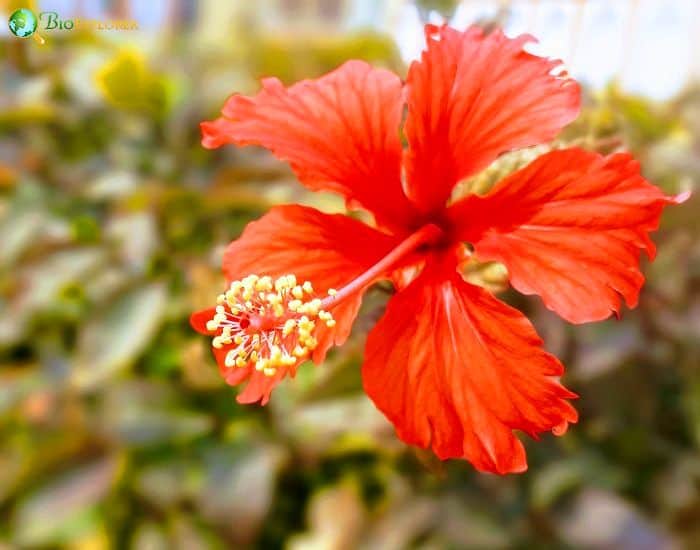
The Mandrinette, also known as the Rodrigues Hibiscus, is one of the rarest hibiscus species in the world. Endemic to Rodrigues, a remote outpost of Mauritius in the Indian Ocean, this critically endangered[40] plant represents a unique piece of the island’s biodiversity.
Its story is one of near-Extinction and conservation triumph, making it not just a beautiful flower but a powerful symbol of the importance of preserving our planet’s rare and threatened species.

- Flower Size: 2-3 inches in diameter.
- Colors: Bright pink to red.
- Blooming Season: Primarily in summer, but can flower year-round in ideal conditions.
- Height: Typically grows as a shrub 3-6 feet tall.
- Leaves: Simple, ovate to lanceolate, with serrated edges.

Endemic to Mauritius and found on steep slopes of the mountains Corps de Garde and Le Morne Brabant on Mauritius, with two additional plants on Rodrigues.

- At one point, only two plants were known to exist in the wild.
- Intensive conservation efforts have increased its numbers, but it remains critically endangered.
- The species is considered a flagship for conservation efforts on Rodrigues Island.
- Its flowers are believed to be pollinated by the Rodrigues fody, an endemic Bird Species.
- The flowers are 7-10 cm in diameter with bright pink to carmine red petals.
- Despite its rarity, it has been successfully propagated and is sometimes available to specialist collectors.
- Andy Warhol made prints titled “Flowers” of the mandrinette in 1970, based on a photograph by Patricia Caulfield[41].
25. Rose-of-Venezuela (Hibiscus rosa-sinensis)
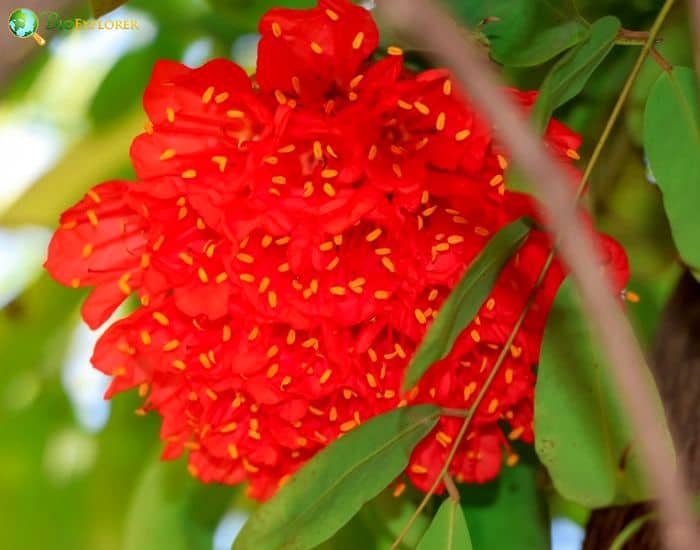
| Plantae | Malvales | Malvaceae | Hibiscus | Hibiscus rosa-sinensis |
The Rose-of-Venezuela, despite its name, is not native to Venezuela but is a cultivar of the Chinese Hibiscus (Hibiscus rosa-sinensis). This particular variety has gained popularity for its striking flowers and ease of cultivation, making it a favorite among hibiscus enthusiasts and gardeners worldwide.
Its large, showy blooms and glossy foliage embody the tropical allure that has made hibiscus plants so beloved in warm climates and as houseplants in cooler regions.

- Flower Size: 4-6 inches in diameter.
- Colors: Typically, deep red or crimson, sometimes with a darker center.
- Blooming Season: Year-round in tropical climates, summer to fall in temperate regions.
- Height: 6-10 feet tall when grown outdoors, smaller when container-grown.
- Leaves: Dark green, glossy, ovate to lanceolate.

It doesn’t have a natural habitat as a cultivar, but it’s widely grown in tropical and subtropical regions worldwide.

- Despite its common name, it’s not native to Venezuela but is a cultivar of the Chinese Hibiscus.
- The flowers are edible and sometimes used in salads or as a garnish[42].
- In tropical regions, it’s often used as a hedge plant due to its dense growth habit.
- The plant is widely used in traditional medicine in various cultures.
- Its vibrant red flowers are particularly attractive to hummingbirds and butterflies[43].
- In the language of flowers, the red Hibiscus symbolizes passionate love.
Hibiscus Care 101: Keeping Your Blooms Happy
Let’s dive into the nitty-gritty of hibiscus care. Whether you’re a seasoned green thumb or a newbie, these tips will help your Hibiscus thrive.
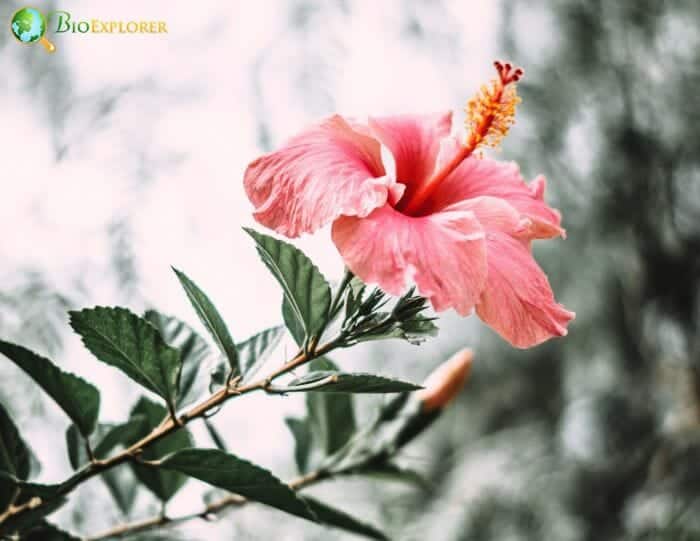
General Care Tips for Thriving Hibiscus
- Sunlight: Hibiscus loves the sun! Most varieties need 6-8 hours of direct sunlight daily.
- Water: Keep the soil moist but not waterlogged. Water deeply when the top inch of soil feels dry.
- Soil: Well-draining, rich soil is key. A pH between 6.0-6.8 is ideal.
- Temperature: Most Hibiscus prefer warm temperatures between 60-90°F (15-32°C).
- Fertilizer: Feed your Hibiscus regularly during the growing season with a balanced, high-potassium fertilizer.
Pro Tip: Prune your Hibiscus in early spring to encourage bushy growth and more blooms.
| Sunlight | Full sun | Full to partial sun |
| Water | Frequent | Moderate |
| Hardiness | Zones 9-11 | Zones 4-9 |
| Blooming | Year-round possible | Summer to fall |
Tropical vs. Hardy: What’s the Difference?
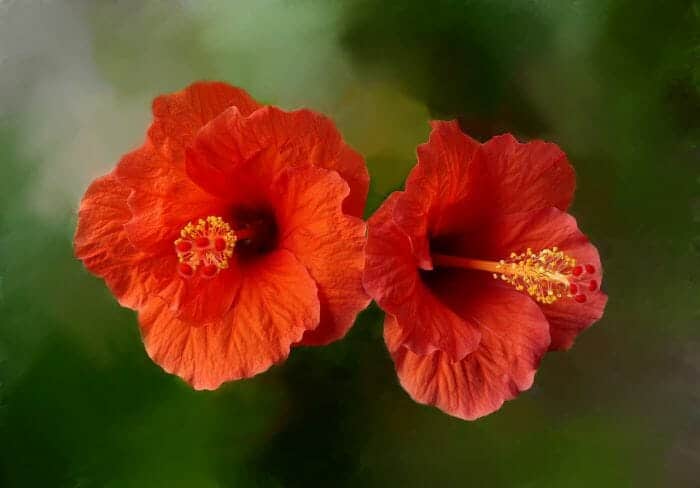
Hibiscus plants fall into two main categories: tropical and hardy. Here’s how they stack up:
Tropical Hibiscus:
- Native to warm climates.
- Evergreen in frost-free areas.
- More sensitive to cold.
- Often grown as houseplants in cooler regions.
- Examples: Hibiscus rosa-sinensis, Hibiscus arnottianus.
Hardy Hibiscus:
- Can survive colder temperatures.
- Die back to the ground in winter, resurface in spring.
- Larger flowers but shorter blooming period.
- Examples: Hibiscus moscheutos, Hibiscus syriacus.
“Understanding whether your hibiscus is tropical or hardy is the first step to giving it the care it needs to thrive. ” – Jane Green, Master Gardener
Common Hibiscus Care Mistakes to Avoid:
- Overwatering
- Insufficient light
- Forgetting to fertilize
- Ignoring pest problems
- Improper winter care for hardy varieties.
Frequently Asked Questions
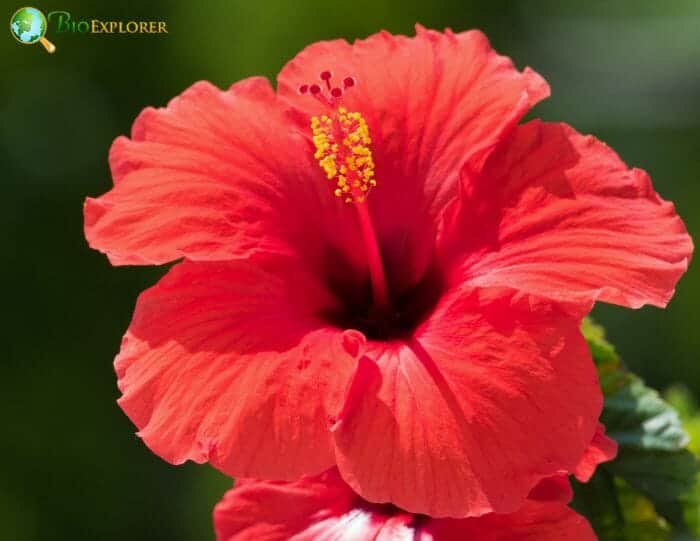
How often should I water my Hibiscus?
Most Hibiscus prefer consistently moist soil. Water when the top inch of soil feels dry, typically 2-3 times a week in summer and less in winter.
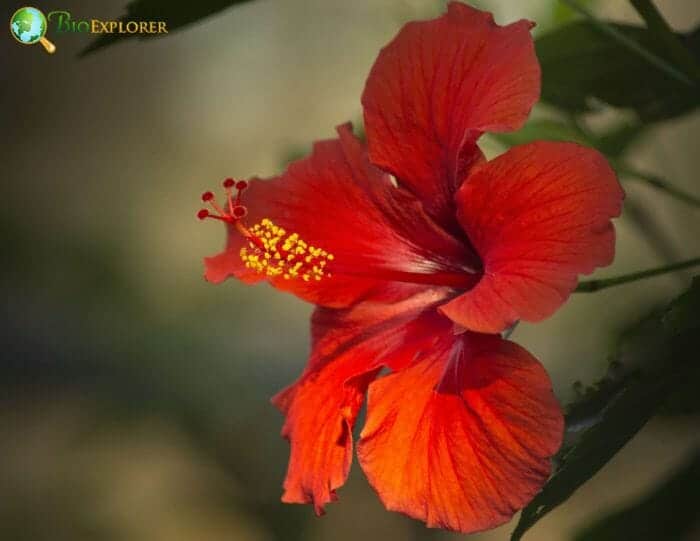
Can Hibiscus be grown indoors?
Yes, tropical hibiscus varieties can be grown as houseplants in bright, sunny locations.
Why are the leaves on my Hibiscus turning yellow?
Yellow leaves can indicate overwatering, underwatering, nutrient deficiency, or pest problems. Check your watering habits and soil condition first.
Do all hibiscus flowers only last one day?
Many hibiscus flowers last only a day, but the plant produces new blooms continuously during the flowering season.
How do I overwinter my hibiscus?
Tropical Hibiscus should be brought indoors before frost. Hardy hibiscus can be cut back and mulched heavily in colder regions.
Are hibiscus plants toxic to pets?
Most Hibiscuses are considered non-toxic to cats and dogs, but it’s best to prevent pets from eating large quantities of plants.
How can I encourage more blooms on my Hibiscus?
Ensure your plant gets enough sunlight water appropriately, and fertilize with a high-potassium fertilizer during the growing season.
Can I make tea from any hibiscus flower?
While many hibiscus flowers are edible, hibiscus tea is typically made from Hibiscus sabdariffa (Roselle), not other species.
Wrapping Up: Your Hibiscus Journey Begins Here
We’ve explored the most fascinating hibiscus species and cultivars, each with its own unique charm and characteristics. From the rare Mandrinette to the popular Rose-of-Venezuela, Hibiscus offers incredible diversity in colors, sizes, and growing habits.
Whether you’re a seasoned gardener or a curious newcomer, there’s a hibiscus variety suited to your needs. These flowers bring tropical beauty to gardens and play crucial roles in ecosystems and human cultures worldwide.
Happy gardening, and may your world be a little more colorful with Hibiscus!










